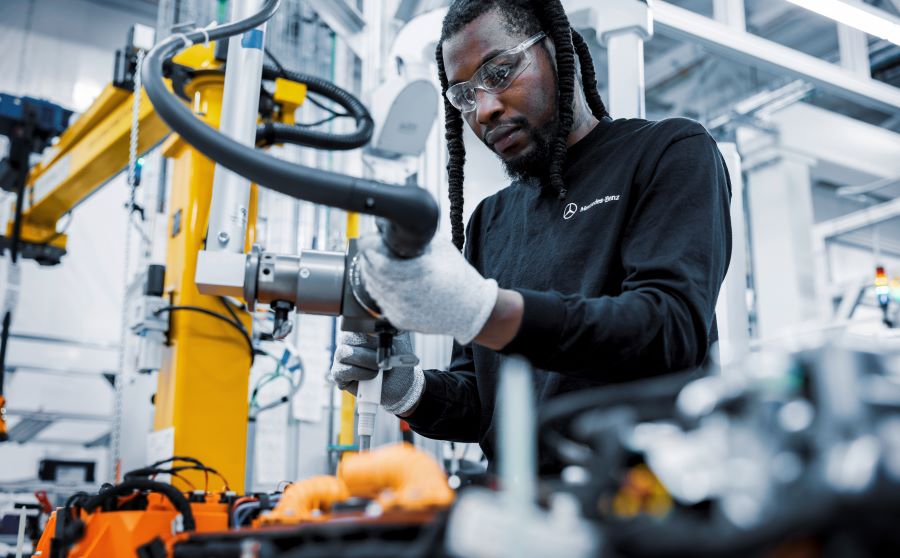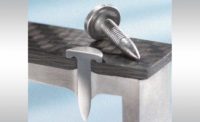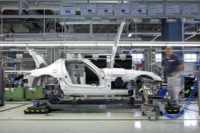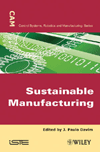STUTTGART, Germany—Mercedes-Benz is increasingly integrating recycled and sustainable materials into its vehicles.
The carmaker has set a goal of having a carbon-neutral fleet of new passenger cars and vans by 2039—11 years earlier than EU legislation requires. Mercedes is paying special attention paid to the careful use of resources. The company is working intensively on closing material cycles, significantly increasing the proportion of recycled materials and researching new materials that are in harmony with nature.
“Our goal is to be the technology leader in environmental engineering by achieving more with less. To this end, we are accelerating our innovation speed and bringing new, sustainable technologies into series production as quickly as possible,” says Markus Schäfer, chief technology officer responsible for development and procurement. “As a pilot program, the EQS and EQE SUVs will be equipped with cable ducts made from UBQ, a plastic substitute material derived from household waste.
“Our vision is to transform our entire value chain into as closed a loop as possible. Our series-production vehicles already contain a large number of recycled materials. Within the next 10 years, we will increase the share of secondary raw materials in our passenger car fleet to an average of 40 percent.”
UBQ is obtained from the conversion of mixed household waste, which has so far been difficult to recycle and is therefore often burned or deposited in a landfill. Feedstock for the material includes food residues, mixed plastics, cardboard and diapers. Further applications such as underbody panels, wheel arch linings and engine compartment covers are currently being tested.
To reduce its environmental footprint, Mercedes is using a variety of innovative materials in its vehicles.
For example, beginning next year, Mercedes will offer only sustainably produced and processed leather in all model series. The consideration ranges from livestock breeding to the tanning process.
At the same time, Mercedes-Benz is conducting intensive research into animal-free alternatives to leather. These should not only be resource-friendly, but also offer the highest quality in all parameters. Promising alternatives are being made from powdered cactus fibers and fungal mycelia. A microfiber fleece fabric is showing promise as a substitute for suede.
Recycled materials are already in series production in many vehicles today. In the interior, for example, Mercedes offers various upholstery fabrics made from up to 100 percent recycled PET bottles. The floor coverings in the EQS use a nylon yarn that comes from recycled carpets and recycled fishing nets. One ton of this yarn saves more than 6.5 tons of CO2 compared to new material.
The company is also looking into several promising experimental materials, such as a high-performance plastic with a painted surface obtained through innovative chemical recycling. In chemical recycling, used tires and otherwise difficult-to-recycle plastic waste are broken down into their chemical components in such a way that absolutely new materials can be produced from them.
Another promising material that could be used in rear seat cushions is a partially CO2-based foam. In the polyol, the main component of this polyurethane foam, CO2 which would otherwise be released into the atmosphere is chemically bound. The carbon dioxide can make up to 20 percent by weight of the polyol.
The automaker is also studying a silk-like, biotechnologically produced textile that is completely free of animal products, as well as carpets made of bamboo fibers.
In addition to interior components, Mercedes is also taking a second look at materials for body and shell components. Mercedes is pursuing a goal of decarbonizing the steel supply chain, deliberately focusing on the avoidance and reduction of CO2 emissions rather than compensation. For example, the Vision EQXX uses CO2-reduced flat steel from Salzgitter Flachstahl GmbH, which is produced 100 percent from scrap in an electric arc furnace. Already, low-alloyed grades of steel, produced with 60 percent less CO2, are being integrated in the A-Class, E-Class, C-Class and the EQE.
In addition, Mercedes-Benz sources steel from the U.S. supplier Big River Steel, which reduces CO2 emissions in steel production by more than 70 percent through the use of recycled steel scrap and renewable energies. By contrast, steel produced using a classical blast furnace emits an average of more than two tons of CO2 per ton.
In the next step, from 2025 Mercedes-Benz will use steel that is almost completely CO2-free in various vehicle models, thanks to manufacturing with hydrogen instead of coking coal. The company has become the first car manufacturer to take an equity stake in the Swedish start-up H2 Green Steel. As part of a partnership with Swedish steelmaker SSAB, the first prototype parts for body-in-white applications made from fossil-free steel are already being planned for this year.
The carmaker is pursuing similar steps with aluminum. For example, in the body‑in‑white of the AMG SL, structural castings made of die-cast alloys made from 100 percent recycled aluminum scrap are being used for the first time. This saves more than 90 percent of CO2 emissions.






